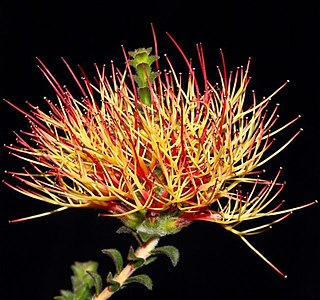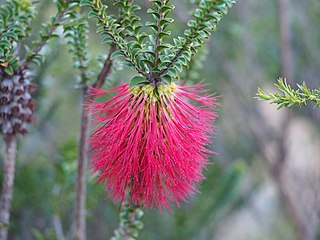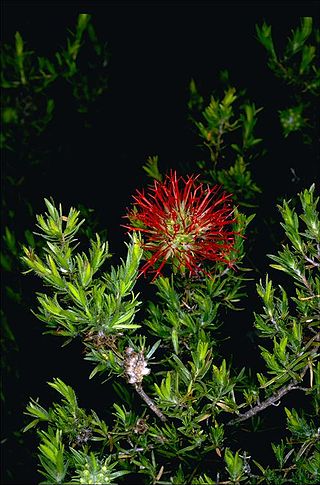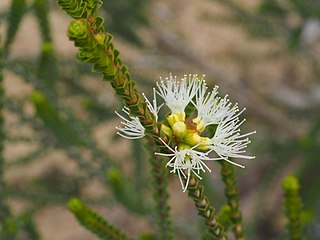
Beaufortia sparsa, commonly known as swamp bottlebrush, is a plant in the myrtle family Myrtaceae, and is endemic to the southwest of Western Australia. It is an erect or spreading shrub with round, dished leaves crowded on the younger stems, and bright red flower spikes in the warmer months.

Calothamnus robustus is a plant in the myrtle family, Myrtaceae and is endemic to the south-west of Western Australia. It is an erect shrub with cylindrical leaves and small clusters of red flowers in spring, followed by fruits with have two prominent lobes.

Beaufortia aestiva, commonly known as Kalbarri beaufortia, or summer flame, is a plant in the myrtle family, Myrtaceae and is endemic to the southwest of Western Australia. It is a dense, usually rounded shrub with small leaves and which bears yellow or red flowers in bottlebrush-like spikes near the ends of the branches in summer. It is similar to Beaufortia squarrosa but that is a smaller shrub which always has red flowers.

Beaufortia bicolor, commonly known as Badgingarra beaufortia, is a plant in the myrtle family, Myrtaceae and is endemic to Southwest Australia. It is a densely branched shrub with rough, peeling bark, elliptical, upward pointing leaves and heads of red, orange and yellow flowers in November or December. It has been classified as a "poorly known" species.

Beaufortia bracteosa is a plant in the myrtle family, Myrtaceae and is endemic to the southwest of Western Australia. It is a shrub growing to a height of about 1 m (3 ft) with red to maroon flowers and woody fruit.

Beaufortia decussata, commonly known as gravel bottlebrush, is a species of flowering plant in the myrtle family, Myrtaceae and is endemic to the southwest of Western Australia. It has long stems branching only near the upper ends, and scarlet to orange-red flowers in a bottlebrush shape beneath the branches.

Beaufortia cyrtodonta, commonly known as Stirling Range bottlebrush, is a plant in the myrtle family, Myrtaceae and is endemic to the southwest of Western Australia. It is a compact shrub with crowded leaves which appear greyish due to their covering of fine, soft hairs. It has heads of red flowers in spring and occurs in the Stirling Range district.

Beaufortia empetrifolia, commonly known as south coast beaufortia, is a plant in the myrtle family, Myrtaceae and is endemic to the southwest of Western Australia. It is a highly branched shrub with small, crowded leaves and pinkish to purple flowers in small, bottlebrush-like spikes in the warmer months. It is similar to Beaufortia micrantha except that its leaves are slightly larger.
Beaufortia eriocephala, commonly known as woolly bottlebrush or woolly beaufortia, is a species of flowering plant in the myrtle family, Myrtaceae and is endemic to the southwest of Western Australia. It differs from other beaufortias in having woolly red flowers and hairy younger leaves, with mature leaves that are less than 1 mm (0.04 in) wide.

Beaufortia incana, commonly known as grey-leaved beaufortia, is a plant in the myrtle family Myrtaceae, and is endemic to southwest of Western Australia. It is a shrub with crowded leaves that appear whitish due to their covering of fine, soft hairs on both surfaces. It has almost spherical heads of red flowers in spring.

Beaufortia macrostemon, commonly known as Darling Range beaufortia, is a plant in the myrtle family, Myrtaceae and is endemic to the southwest of Western Australia. It is a low shrub with multiple stems, hairy young leaves and three stamens in each stamen bundle.

Beaufortia micrantha, commonly known as small-leaved beaufortia or little bottlebrush, is a species of flowering plant in the myrtle family, Myrtaceae and is endemic to the southwest of Western Australia. It is a compact shrub with tiny leaves pressed against the stems and profuse heads of purple or pinkish-coloured flowers.

Beaufortia orbifolia, commonly known as Ravensthorpe bottlebrush, is a species of flowering plant in the myrtle family, Myrtaceae and is endemic to the southwest of Western Australia. It is an erect or spreading shrub with round, dished leaves crowded on the younger stems, and bright red flower spikes. It is found in laterite hills near Ravensthorpe. It is distinguished from other beaufortias by having green stamen bundles with the free ends red.

Beaufortia purpurea, commonly known as purple beaufortia, is a species of flowering plant in the myrtle family, Myrtaceae and is endemic to the southwest of Western Australia. It is an erect or spreading shrub with linear to egg-shaped leaves and purplish-red flowers in dense heads on the ends of branches which continue to grow after flowering.

Beaufortia schaueri, commonly known as pink bottlebrush or pink beaufortia, is a species of flowering plant in the myrtle family, Myrtaceae and is endemic to the southwest of Western Australia. It is a small, rounded shrub with small, crowded, linear leaves and profuse, spherical heads of pink flowers conspicuously displayed on the ends of the branches in spring.

Beaufortia sprengelioides is a species of flowering plant in the myrtle family, Myrtaceae and is endemic to the southwest of Western Australia. It is a rigid, spreading shrub with crowded, round leaves and small, roughly spherical heads of pale pink flowers on the ends of its branches. It was one of the first Australian plant species collected by Europeans and has had several name changes since then.

Beaufortia squarrosa, commonly known as sand bottlebrush, is a species of flowering plant in the myrtle family, Myrtaceae and is endemic to the southwest of Western Australia. The Noongar peoples know the plant as buno. It is sometimes a dense shrub, others straggling with 4 neat rows of small, oval leaves along the stems, and heads of red, orange or yellow flowers in the warmer months.

Regelia inops is a plant in the myrtle family, Myrtaceae and is endemic to the south-west of Western Australia. It is an upright but often spreading shrub with tiny wedge shaped leaves and small heads of pink flowers on the ends of its branches in the warmer months.
Beaufortia burbidgeae, commonly known as column beaufortia, is a plant in the myrtle family, Myrtaceae and is endemic to Southwest Australia. It is a shrub with crowded, needle-shaped leaves and mostly red, or red and green flowers on the ends of the branches from spring to early summer.
Beaufortia kwongkanicola, commonly known as Lesueur beaufortia, is a plant in the myrtle family, Myrtaceae and is endemic to the southwest of Western Australia. It is a shrub with crowded leaves and large, deep purple heads of flowers in late winter and spring and is found in the northern kwongkan.

















